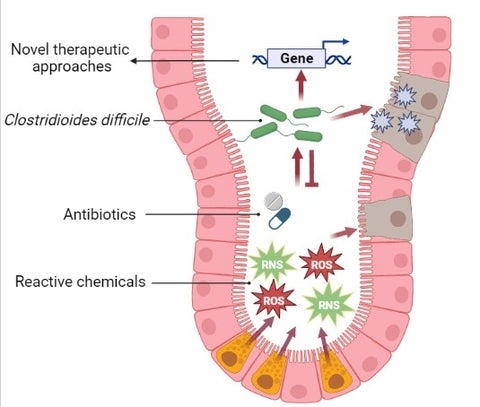
C. difficile combats chemical assaults in the gut.*
*Created with BioRender.com, adapted from “Antimicrobial Peptide Release by Paneth Cells” (2023).
C. difficile is the leading cause of hospital-acquired infection globally, with a huge economic burden running into billions of dollars annually. The recent emergence of epidemic hypervirulent strains and the continued evolution of the pathogen has created a significant knowledge gap in C. difficile epidemiology and biology.
Enteric pathogenic bacteria like C. difficile encounter several chemical onslaughts, including reactive species, upon invading their hosts, and they must withstand these chemical stressors to survive in the host. These reactive species molecules are part of the hosts’ innate (natural) defense systems and are often very toxic to bacteria—including C. difficile—and the host cells, leading to inflammation. However, how C. difficile survives these chemical onslaughts remains unclear.
Further, the emergence and ongoing pathoevolution of C. difficile infection (CDI) continues to change the epidemiology of the disease. This has led to the emergence of antibiotic resistance and an increase in community-acquired CDI (CA-CDI). The molecular basis of these epidemiological changes remains unclear.
Hence, research in our lab is focused broadly on understanding:
- How C. difficile defends itself against reactive chemical stressors and how that impacts virulence and disease severity.
- The molecular factors driving the pathoevolution of C. difficile, including the mechanisms of antibiotic resistance.
- The identification of therapeutic molecules and adjuvants to potentiate the efficacy of available antibiotics.
To accomplish these, our lab employs a multidisciplinary and collaborative approach that combines techniques in microbial genetics, multi-omics (genomics, transcriptomics, metabolomics), drug discovery and animal infection modeling. Hence, our lab also works closely with domain experts across structural biology, computational biology, and medicinal chemistry to expand the frontiers of knowledge and accelerate scientific discovery in these areas. We anticipate that our work will help to unravel novel fundamental insights behind C. difficile pathogenesis that can be translated towards the discovery of innovative approaches for controlling the epidemiology of CDI and other bacterial pathogen infections.